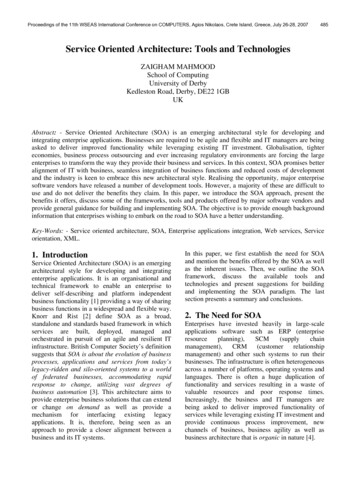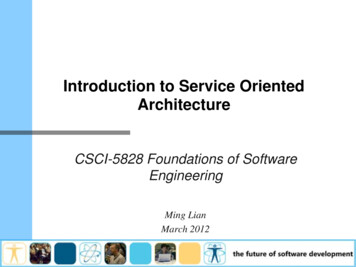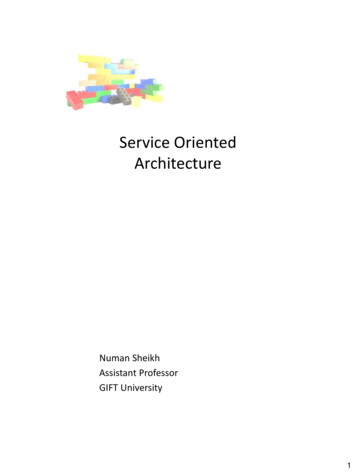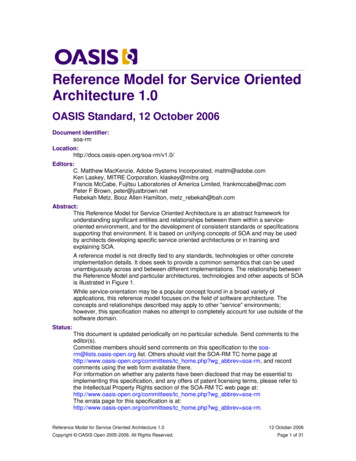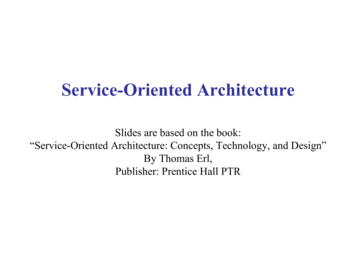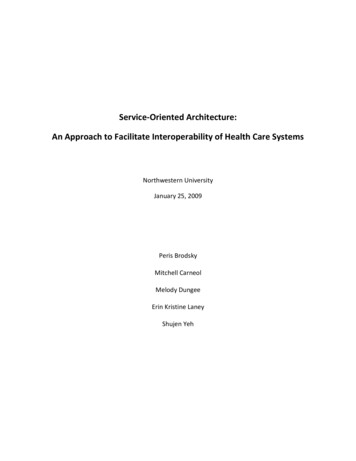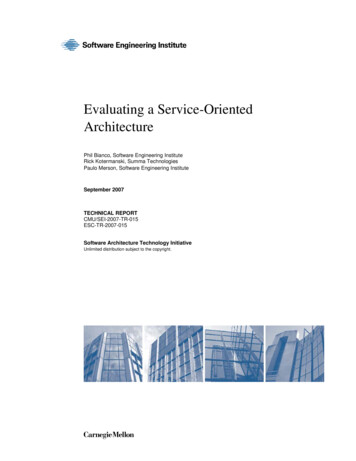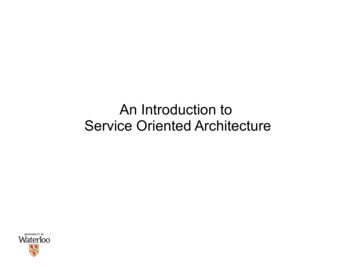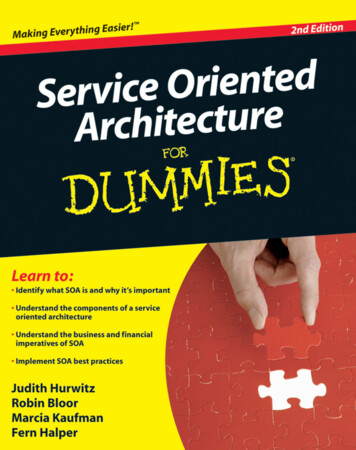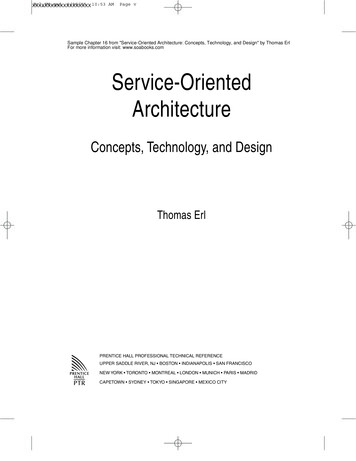
Transcription
Erl FM.qxd 6/30/05 10:53 AMXXXXXXXXXXXXXXXXXXXPage vSample Chapter 16 from "Service-Oriented Architecture: Concepts, Technology, and Design" by Thomas ErlFor more information visit: ts, Technology, and DesignThomas ErlPRENTICE HALL PROFESSIONAL TECHNICAL REFERENCEUPPER SADDLE RIVER, NJ BOSTON INDIANAPOLIS SAN FRANCISCONEW YORK TORONTO MONTREAL LONDON MUNICH PARIS MADRIDCAPETOWN SYDNEY TOKYO SINGAPORE MEXICO CITY
Erl FM.qxd 6/30/05 10:53 AMXXXXXXXXXXXXXXXXXXXPage viSample Chapter 16 from "Service-Oriented Architecture: Concepts, Technology, and Design" by Thomas ErlFor more information visit: www.soabooks.comMany of the designations used by manufacturers and sellers to distinguish theirproducts are claimed as trademarks. Where those designations appear in this book, andthe publisher was aware of a trademark claim, the designations have been printed withinitial capital letters or in all capitals.The authors and publisher have taken care in the preparation of this book, but make noexpressed or implied warranty of any kind and assume no responsibility for errors oromissions. No liability is assumed for incidental or consequential damages in connection with or arising out of the use of the information or programs contained herein.The publisher offers excellent discounts on this book when ordered in quantity for bulkpurchases or special sales, which may include electronic versions and/or custom covers and content particular to your business, training goals, marketing focus, and branding interests. For more information, please contact:U. S. Corporate and Government Sales(800) 382-3419corpsales@pearsontechgroup.comFor sales outside the U. S., please contact:International Salesinternational@pearsoned.comVisit us on the Web: www.phptr.comLibrary of Congress Number: 2005925019Copyright 2005 Pearson Education, Inc. Portions of this work are copyright SOASystems Inc., and reprinted with permission from SOA Systems Inc. 2005. Front coverand all photographs by Thomas Erl. Permission to use photographs granted by SOASystems Inc.All rights reserved. Printed in the United States of America. This publication isprotected by copyright, and permission must be obtained from the copyright holderprior to any prohibited reproduction, storage in a retrieval system, or transmission inany form or by any means, electronic, mechanical, photocopying, recording, or likewise.For information regarding permissions, write to:Pearson Education, Inc.Rights and Contracts DepartmentOne Lake StreetUpper Saddle River, NJ 07458ISBN 0-13-185858-0Text printed in the United States on recycled paper at R.R. Donnelley inCrawfordsville, Indiana.First printing, July 2005
Sample Chapter 16 from "Service-Oriented Architecture: Concepts, Technology, and Design" by Thomas ErlFor more information visit: www.soabooks.comChapter 16Service-Oriented Design(Part IV: Business ProcessDesign)16.1 WS-BPEL language basics16.2 WS-Coordination overview16.3 Service-oriented business process design(a step-by-step process)
Sample Chapter 16 from "Service-Oriented Architecture: Concepts, Technology, and Design" by Thomas ErlFor more information visit: www.soabooks.comhe orchestration service layer provides a powerful means by which contemporary service-oriented solutions can realize some key benefits. The mostsignificant contribution this sub-layer brings to SOA is an abstraction of logicand responsibility that alleviates underlying services from a number of designconstraints.TFor example, by abstracting business process logic: Application and business services can be freely designed to be process-agnostic andreusable. The process service assumes a greater degree of statefulness, thus further freeingother services from having to manage state. The business process logic is centralized in one location, as opposed to being distributed across and embedded within multiple services.In this chapter we tackle the design of an orchestration layer by using the WS-BPEL language to create a business process definition.How case studies are used: Our focus in this chapter is the TLS environment. Weprovide case study examples throughout the step-by-step process descriptionduring which TLS builds a WS-BPEL process definition for the Timesheet Submission Process. This is the same process for which service candidates were modeled in Chapter 12 and for which the Employee Service interface was designed inChapter 15.16.1WS-BPEL language basicsBefore we can design an orchestration layer, we need to acquire a good understandingof how the operational characteristics of the process can be formally expressed. Thisbook uses the WS-BPEL language to demonstrate how process logic can be described aspart of a concrete definition (Figure 16.1) that can be implemented and executed via acompliant orchestration engine.
Sample Chapter 16 from "Service-Oriented Architecture: Concepts, Technology, and Design" by Thomas ErlFor more information visit: www.soabooks.com567WS-BPEL language basicsFigure 16.1A common WS-BPEL process definitionstructure.Although you likely will be using a process modeling tool and will therefore not berequired to author your process definition from scratch, a knowledge of WS-BPEL elements still is useful and often required. WS-BPEL modeling tools frequently make reference to these elements and constructs, and you may be required to dig into the sourcecode they produce to make further refinements.NOTEIf you are already comfortable with the WS-BPEL language, feel free to skipahead to the Service-oriented business process design (a step-by-stepprocess) section.16.1.1A brief history of BPEL4WS and WS-BPELBefore we get into the details of the WS-BPEL language, let’s briefly discuss how thisspecification came to be. The Business Process Execution Language for Web Services(BPEL4WS) was first conceived in July, 2002, with the release of the BPEL4WS 1.0specification, a joint effort by IBM, Microsoft, and BEA. This document proposed an
Sample Chapter 16 from "Service-Oriented Architecture: Concepts, Technology, and Design" by Thomas ErlFor more information visit: www.soabooks.com568Chapter 16: Service-Oriented Design (Part IV: Business Process Design)orchestration language inspired by previous variations, such as IBM’s Web ServicesFlow Language (WSFL) and Microsoft’s XLANG specification.Joined by other contributors from SAP and Siebel Systems, version 1.1 of the BPEL4WSspecification was released less than a year later, in May of 2003. This version receivedmore attention and vendor support, leading to a number of commercially availableBPEL4WS-compliant orchestration engines. Just prior to this release, the BPEL4WSspecification was submitted to an OASIS technical committee so that the specificationcould be developed into an official, open standard.The technical committee is in the process of finalizing the release of the next version ofBPEL4WS. It has been announced that the language itself has been renamed to the WebServices Business Process Execution Language, or WS-BPEL (and assigned the 2.0 version number). The changes planned for WS-BPEL have been made publicly available onthe OASIS Web site at www.oasis-open.org.Notes have been added to the element descriptions in this section where appropriate toindicate changes in syntax between BPEL4WS and WS-BPEL. For simplicity’s sake, werefer to the Business Process Execution Language as WS-BPEL in this book.16.1.2PrerequisitesIt’s time now to learn about the WS-BPEL language. If you haven’t already done so, it isrecommended that you read Chapter 6 prior to proceeding with this section. Conceptsrelating to orchestration, coordination, atomic transactions, and business activities arecovered in Chapter 6, and are therefore not repeated here. This chapter also assumes youhave read through the WSDL tutorial provided in Chapter 13.16.1.3The process elementLet’s begin with the root element of a WS-BPEL process definition. It is assigned a namevalue using the name attribute and is used to establish the process definition-relatednamespaces. process name "TimesheetSubmissionProcess"targetNamespace "http://www.xmltc.com/tls/process/"xmlns ocess/"xmlns:bpl "http://www.xmltc.com/tls/process/"xmlns:emp "http://www.xmltc.com/tls/employee/"xmlns:inv "http://www.xmltc.com/tls/invoice/"
Sample Chapter 16 from "Service-Oriented Architecture: Concepts, Technology, and Design" by Thomas ErlFor more information visit: www.soabooks.comWS-BPEL language basics569xmlns:tst "http://www.xmltc.com/tls/timesheet/"xmlns:not "http://www.xmltc.com/tls/notification/" partnerLinks . /partnerLinks variables . /variables sequence . /sequence . /process Example 16.1A skeleton process definition.The process construct contains a series of common child elements explained in the following sections.16.1.4The partnerLinks and partnerLink elementsA partnerLink element establishes the port type of the service (partner) that will be participating during the execution of the business process. Partner services can act as aclient to the process, responsible for invoking the process service. Alternatively, partnerservices can be invoked by the process service itself.The contents of a partnerLink element represent the communication exchange betweentwo partners—the process service being one partner and another service being the other.Depending on the nature of the communication, the role of the process service will vary.For instance, a process service that is invoked by an external service may act in the roleof “TimesheetSubmissionProcess.” However, when this same process service invokes adifferent service to have an invoice verified, it acts within a different role, perhaps“InvoiceClient.” The partnerLink element therefore contains the myRole and partnerRole attributes that establish the service provider role of the process service and thepartner service respectively.Put simply, the myRole attribute is used when the process service is invoked by a partner client service, because in this situation the process service acts as the serviceprovider. The partnerRole attribute identifies the partner service that the process service will be invoking (making the partner service the service provider).
Sample Chapter 16 from "Service-Oriented Architecture: Concepts, Technology, and Design" by Thomas ErlFor more information visit: www.soabooks.com570Chapter 16: Service-Oriented Design (Part IV: Business Process Design)Note that both myRole and partnerRole attributes can be used by the same partnerLink element when it is expected that the process service will act as both servicerequestor and service provider with the same partner service. For example, during asynchronous communication between the process and partner services, the myRole settingindicates the process service’s role during the callback of the partner service. partnerLinks partnerLink name "client"partnerLinkType "tns:TimesheetSubmissionType"myRole "TimesheetSubmissionServiceProvider"/ partnerLink name "Invoice"partnerLinkType "inv:InvoiceType"partnerRole "InvoiceServiceProvider"/ partnerLink name "Timesheet"partnerLinkType "tst:TimesheetType"partnerRole "TimesheetServiceProvider"/ partnerLink name "Employee"partnerLinkType "emp:EmployeeType"partnerRole "EmployeeServiceProvider"/ partnerLink name "Notification"partnerLinkType "not:NotificationType"partnerRole "NotificationServiceProvider"/ /partnerLinks Example 16.2The partnerLinks construct containing one partnerLink element in whichthe process service is invoked by an external client partner and four partnerLink elements that identify partner services invoked by the process service.You’ll notice that in Example 16.2, each of the partnerLink elements also contains apartnerLinkType attribute. This refers to the partnerLinkType construct, as explainednext.16.1.5The partnerLinkType elementFor each partner service involved in a process, partnerLinkType elements identify theWSDL portType elements referenced by the partnerLink elements within the processdefinition. Therefore, these constructs typically are embedded directly within the WSDLdocuments of every partner service (including the process service).The partnerLinkType construct contains one role element for each role the service canplay, as defined by the partnerLink myRole and partnerRole attributes. As a result, apartnerLinkType will have either one or two child role elements.
Sample Chapter 16 from "Service-Oriented Architecture: Concepts, Technology, and Design" by Thomas ErlFor more information visit: www.soabooks.com571WS-BPEL language basics definitions name "Employee"targetNamespace "http://www.xmltc.com/tls/employee/wsdl/"xmlns "http://schemas.xmlsoap.org/wsdl/"xmlns:plnk k/". . plnk:partnerLinkType name "EmployeeServiceType" xmlns k/" plnk:role name "EmployeeServiceProvider" portType name "emp:EmployeeInterface"/ /plnk:role /plnk:partnerLinkType . /definitions Example 16.3A WSDL definitions construct containing a partnerLinkType construct.Note that multiple partnerLink elements can reference the same partnerLinkType.This is useful for when a process service has the same relationship with multiple partner services. All of the partner services can therefore use the same process service portType elements.NOTEIn version 2.0 of the WS-BPEL specification, it is being proposed that the portType element be changed so that it exists as an attribute of the role element.16.1.6The variables elementWS-BPEL process services commonly use the variables construct to store state information related to the immediate workflow logic. Entire messages and data sets formatted as XSD schema types can be placed into a variable and retrieved later during thecourse of the process. The type of data that can be assigned to a variable element needsto be predefined using one of the following three attributes: messageType, element, ortype.The messageType attribute allows for the variable to contain an entire WSDL-definedmessage, whereas the element attribute simply refers to an XSD element construct.The type attribute can be used to just represent an XSD simpleType, such as string orinteger.
Sample Chapter 16 from "Service-Oriented Architecture: Concepts, Technology, and Design" by Thomas ErlFor more information visit: www.soabooks.com572Chapter 16: Service-Oriented Design (Part IV: Business Process Design) variables variable name "ClientSubmission"messageType "bpl:receiveSubmitMessage"/ variable name "EmployeeHoursRequest"messageType "emp:getWeeklyHoursRequestMessage"/ variable name "EmployeeHoursResponse"messageType "emp:getWeeklyHoursResponseMessage"/ variable name "EmployeeHistoryRequest"messageType "emp:updateHistoryRequestMessage"/ variable name "EmployeeHistoryResponse"messageType "emp:updateHistoryResponseMessage"/ . /variables Example 16.4The variables construct hosting only some of the child variable elementsused later by the Timesheet Submission Process.Typically, a variable with the messageType attribute is defined for each input and output message processed by the process definition. The value of this attribute is the message name from the partner process definition.16.1.7The getVariableProperty and getVariableData functionsWS-BPEL provides built-in functions that allow information stored in or associated withvariables to be processed during the execution of a business process.getVariableProperty(variable name, property name)This function allows global property values to be retrieved from variables. It simplyaccepts the variable and property names as input and returns the requested value.getVariableData(variable name, part name, location path)Because variables commonly are used to manage state information, this function isrequired to provide other parts of the process logic access to this data. The getVariableData function has a mandatory variable name parameter and two optional arguments that can be used to specify a part of the variable data.In our examples we use the getVariableData function a number of times to retrievemessage data from variables.
Sample Chapter 16 from "Service-Oriented Architecture: Concepts, Technology, and Design" by Thomas ErlFor more information visit: www.soabooks.comWS-BPEL language basics573getVariableData iableData ample 16.516.1.8Two getVariableData functions being used to retrieve specific pieces ofdata from different variables.The sequence elementThe sequence construct allows you to organize a series of activities so that they are executed in a predefined, sequential order. WS-BPEL provides numerous activities that canbe used to express the workflow logic within the process definition. The remaining element descriptions in this section explain the fundamental set of activities used as part ofour upcoming case study examples. sequence receive . /receive assign . /assign invoke . /invoke reply . /reply /sequence Example 16.6A skeleton sequence construct containing only some of the many activityelements provided by WS-BPEL.Note that sequence elements can be nested, allowing you to define sequences withinsequences.
Sample Chapter 16 from "Service-Oriented Architecture: Concepts, Technology, and Design" by Thomas ErlFor more information visit: www.soabooks.com57416.1.9Chapter 16: Service-Oriented Design (Part IV: Business Process Design)The invoke elementThis element identifies the operation of a partner service that the process definitionintends to invoke during the course of its execution. The invoke element is equippedwith five common attributes, which further specify the details of the invocation(Table 16.1).Table 16.1invoke element attributesAttributeDescriptionpartnerLinkThis element names the partner service via its corresponding partnerLink.portTypeThe element used to identify the portType element of thepartner service.operationThe partner service operation to which the process servicewill need to send its request.inputVariableThe input message that will be used to communicate withthe partner service operation. Note that it is referred to as avariable because it is referencing a WS-BPEL variable element with a messageType attribute.outputVariableThis element is used when communication is based on therequest-response MEP. The return value is stored in a separate variable element. invoke name "ValidateWeeklyHours"partnerLink "Employee"portType "emp:EmployeeInterface"operation "GetWeeklyHoursLimit"inputVariable "EmployeeHoursRequest"outputVariable "EmployeeHoursResponse"/ Example 16.7The invoke element identifying the target partner service details.
Sample Chapter 16 from "Service-Oriented Architecture: Concepts, Technology, and Design" by Thomas ErlFor more information visit: www.soabooks.com575WS-BPEL language basics16.1.10The receive elementThe receive element allows us to establish the information a process service expectsupon receiving a request from an external client partner service. In this case, the processservice is viewed as a service provider waiting to be invoked.The receive element contains a set of attributes, each of which is assigned a value relating to the expected incoming communication (Table 16.2).Table 16.2receive element attributesAttributeDescriptionpartnerLinkThe client partner service identified in the correspondingpartnerLink construct.portTypeThe process service portType that will be waiting to receivethe request message from the partner service.operationThe process service operation that will be receiving therequest.variableThe process definition variable construct in which theincoming request message will be stored.createInstanceWhen this attribute is set to “yes,” the recei
The orchestration service layer provides a powerful means by which contempo-rary service-oriented solutions can realize some key benefits. The most significant contribution this sub-layer brings to SOA is an abstraction of logic and responsibility that alleviates

